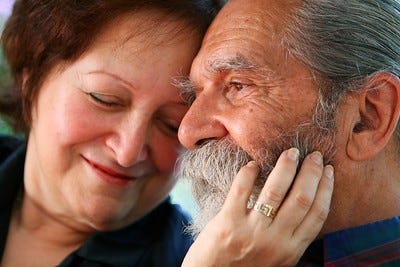This is my twelfth weekly post here at The Pleasure Principle, and, until now, I’ve scarcely written about what most people think about first at the mention of pleasure—sex and desire. But I can resist that topic no longer, because I recently came across an amazing article, in a mainstream publication, about older women and affairs.
Next Avenue is an online newsletter for PBS viewers over 50. It’s middle of the road culturally (they rejected my piece about getting body-painted as too radical for their audience). So I was shocked, in a happy way, to see Sara Zeff Geber’s article “The 4 Most Common Types of ‘Gray Affairs.’” The tease reads: Are extramarital affairs confined to those in the first half of life? Does a woman's interest in having a romantic relationship outside of the marriage vows wane after menopause? Apparently not.
Go here to read the full piece:
The 4 Most Common Types of ‘Gray Affairs’
Geber interviews Susan Shapiro Barash, who has studied various aspects of infidelity over a 30-year period. Barash says so-called “gray affairs” (a dismal name!) used to be unusual, but now they are quite common. Today, many more women over 50 than ever before reported having affairs, and an astonishing 90% of the women involved have no guilt or remorse about their actions. The heroine in my new novel, Cybill Unbound, also has joyful and guiltless affairs, into her fifties and sixties, so I am relieved to see she has company. Novelists want their characters to be unique yet also representative. Still, the article surprised me.
Numbers, numbers, I longed for some numbers! Big data, any data, where are you now? Instead, we get the weaselly paragraph:
“Barash's anecdotal research does not lend itself to an estimate of the prevalence of infidelity in older women. In other literature, there are widely varying estimates of the prevalence of infidelity in American society. Some experts claim it is as low as 35%, other put it at over 50%. Reliable numbers are difficult to find in the literature and most researchers agree that the subject is challenging to study due to the reluctance of subjects to honestly disclose their behavior.”
Nonetheless, Geber’s Next Avenue article is extraordinary. The words “cheat,” and “unfaithful” are nowhere to be found; the women conducting these affairs are described as having “a greater sense of self-esteem. . . and a sense of agency in their lives that wasn’t true for most women 30 years ago.” Barash finds that older women have affairs for the same reasons as younger women, and she provides four general categories. There are Empowering Affairs, with the women having liaisons with younger men. There are Sex-Driven Affairs, where women are getting physical thrills their marriages don’t provide. There are Self Esteem Affairs, where the women step out of their usual roles as nurturing mothers and wives to assume different roles. And there are the Love Affairs, which happen when women least expect them, and which can challenge the marriage.
Yet overall, and this is perhaps the most startling aspect of this piece, “extramarital affairs don’t necessarily lead to the break-up of the marriage.” Perhaps more people are realizing that “an affair may serve as a pressure-release valve on the marriage, lowering a woman’s expectations of her husband to be all things to her, and in an odd way allowing her to be happier within her marriage.”
There have always been artistic and social communities where affairs were tolerated and even encouraged. Think of Bloomsbury and the hippie communes! Nonetheless, I find it surprising and significant that a mainstream publication like Next Avenue has just published an article like this, where affairs are not condemned but merely categorized. Could Americans be adopting a more tolerant, more European view of extramarital liaisons?




Interesting but puzzling report on that column. Thank you.